Leadership and Management Roles in Operations: Deloitte Report
VerifiedAdded on 2020/06/05
|16
|4865
|71
Report
AI Summary
This report provides a comprehensive analysis of leadership and management roles, particularly within the context of Deloitte, a UK-based management consultancy firm. It begins by differentiating between the characteristics and responsibilities of leaders and managers, emphasizing their roles in decision-making, delegation, and employee engagement. The report then explores the application of these roles in various situations, highlighting the importance of both leaders and managers in driving business objectives and achieving organizational goals. Furthermore, it delves into different leadership theories and models, such as situational and contingency approaches, illustrating their strengths and weaknesses. The report also examines key approaches to operations management, the factors influencing operational decisions, and the overall value of effective operations management in achieving business success. This detailed analysis offers valuable insights into the practical application of leadership and management principles within a real-world business environment.
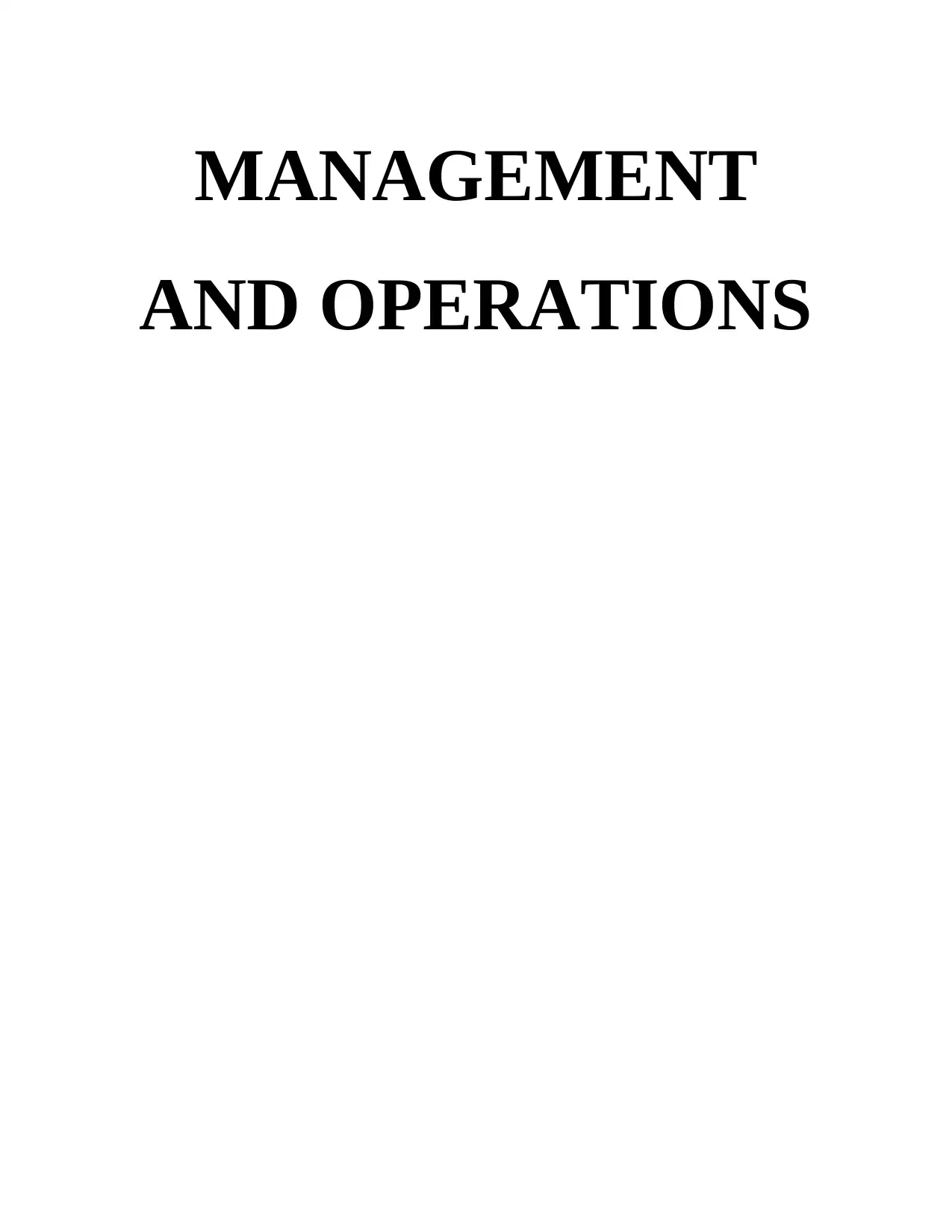
MANAGEMENT
AND OPERATIONS
AND OPERATIONS
Paraphrase This Document
Need a fresh take? Get an instant paraphrase of this document with our AI Paraphraser
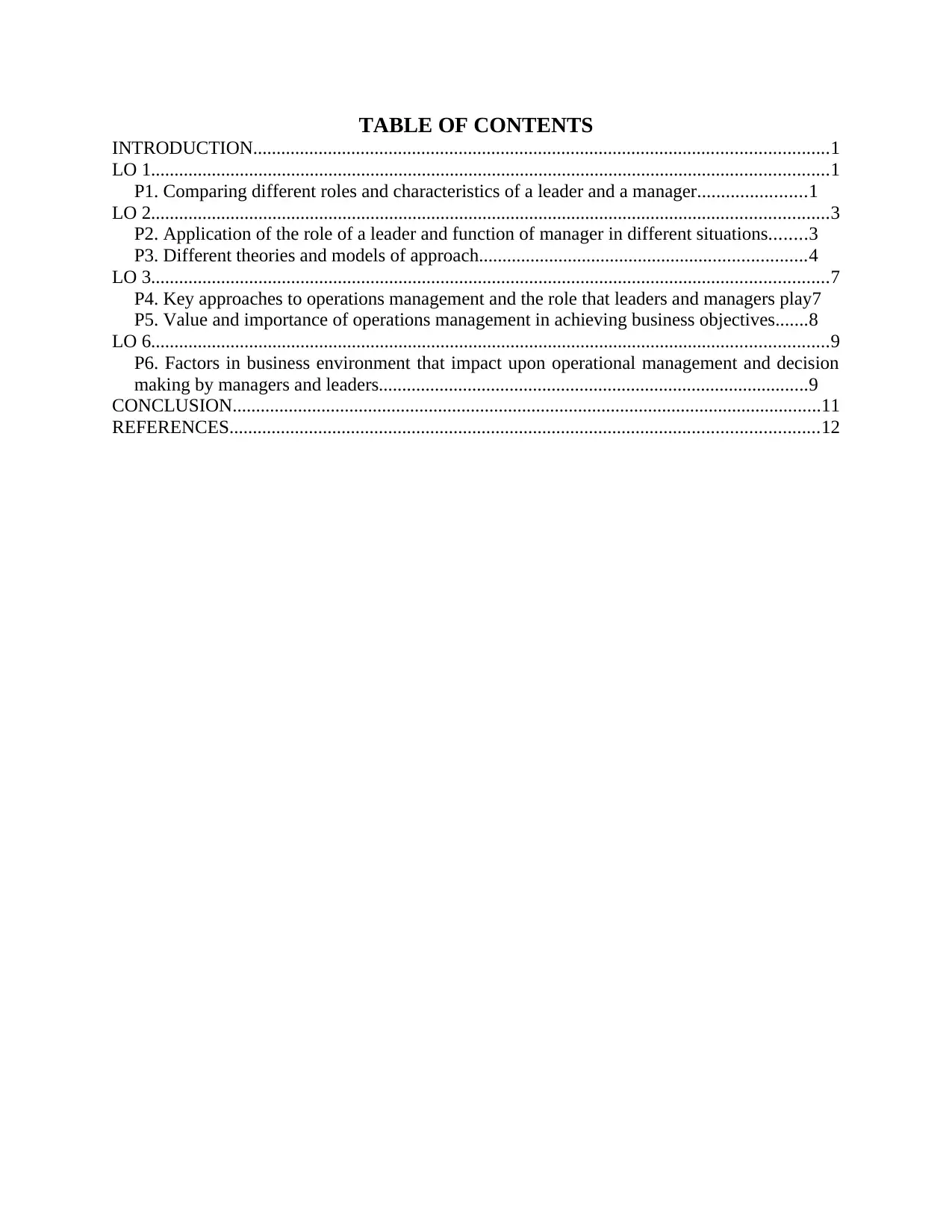
TABLE OF CONTENTS
INTRODUCTION...........................................................................................................................1
LO 1.................................................................................................................................................1
P1. Comparing different roles and characteristics of a leader and a manager.......................1
LO 2.................................................................................................................................................3
P2. Application of the role of a leader and function of manager in different situations........3
P3. Different theories and models of approach......................................................................4
LO 3.................................................................................................................................................7
P4. Key approaches to operations management and the role that leaders and managers play7
P5. Value and importance of operations management in achieving business objectives.......8
LO 6.................................................................................................................................................9
P6. Factors in business environment that impact upon operational management and decision
making by managers and leaders............................................................................................9
CONCLUSION..............................................................................................................................11
REFERENCES..............................................................................................................................12
INTRODUCTION...........................................................................................................................1
LO 1.................................................................................................................................................1
P1. Comparing different roles and characteristics of a leader and a manager.......................1
LO 2.................................................................................................................................................3
P2. Application of the role of a leader and function of manager in different situations........3
P3. Different theories and models of approach......................................................................4
LO 3.................................................................................................................................................7
P4. Key approaches to operations management and the role that leaders and managers play7
P5. Value and importance of operations management in achieving business objectives.......8
LO 6.................................................................................................................................................9
P6. Factors in business environment that impact upon operational management and decision
making by managers and leaders............................................................................................9
CONCLUSION..............................................................................................................................11
REFERENCES..............................................................................................................................12
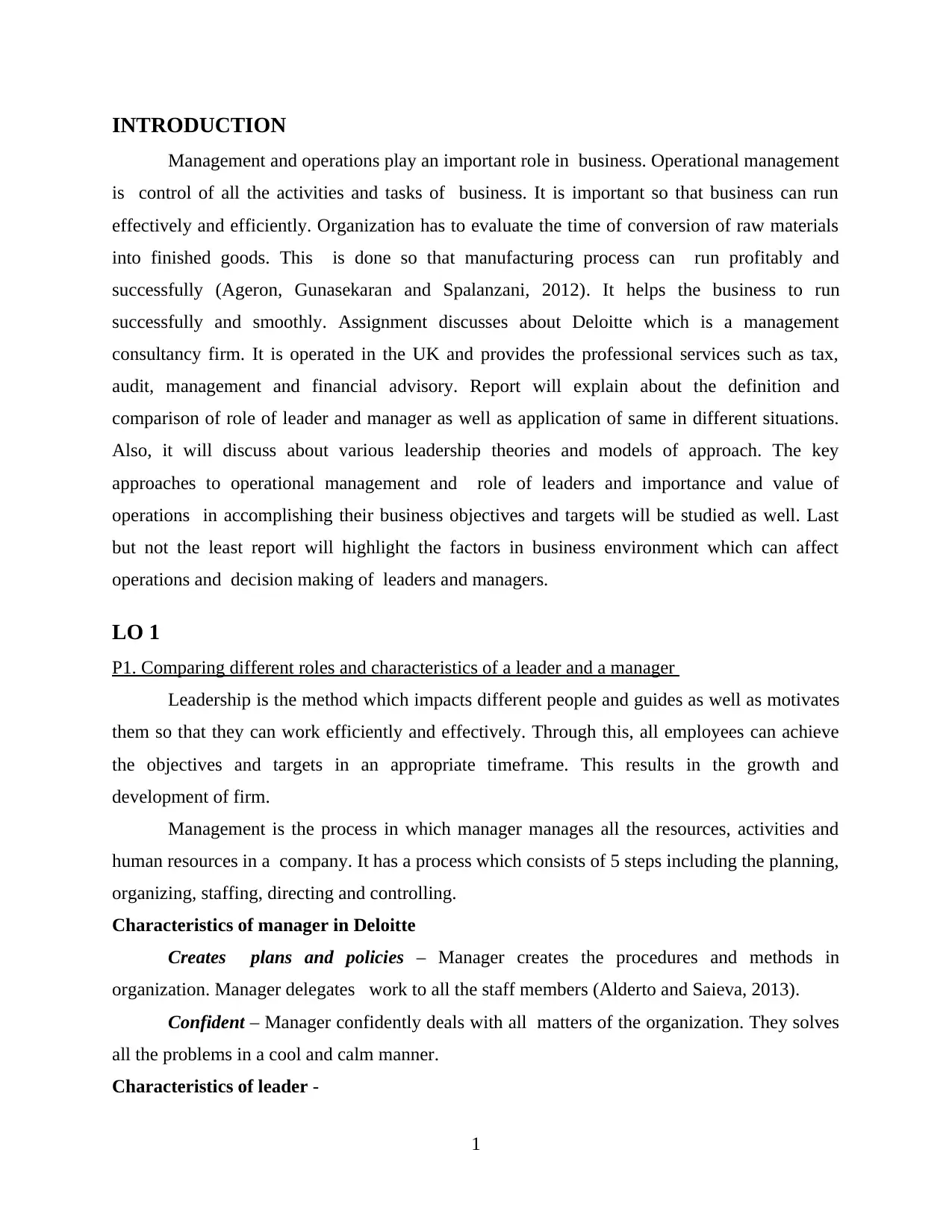
INTRODUCTION
Management and operations play an important role in business. Operational management
is control of all the activities and tasks of business. It is important so that business can run
effectively and efficiently. Organization has to evaluate the time of conversion of raw materials
into finished goods. This is done so that manufacturing process can run profitably and
successfully (Ageron, Gunasekaran and Spalanzani, 2012). It helps the business to run
successfully and smoothly. Assignment discusses about Deloitte which is a management
consultancy firm. It is operated in the UK and provides the professional services such as tax,
audit, management and financial advisory. Report will explain about the definition and
comparison of role of leader and manager as well as application of same in different situations.
Also, it will discuss about various leadership theories and models of approach. The key
approaches to operational management and role of leaders and importance and value of
operations in accomplishing their business objectives and targets will be studied as well. Last
but not the least report will highlight the factors in business environment which can affect
operations and decision making of leaders and managers.
LO 1
P1. Comparing different roles and characteristics of a leader and a manager
Leadership is the method which impacts different people and guides as well as motivates
them so that they can work efficiently and effectively. Through this, all employees can achieve
the objectives and targets in an appropriate timeframe. This results in the growth and
development of firm.
Management is the process in which manager manages all the resources, activities and
human resources in a company. It has a process which consists of 5 steps including the planning,
organizing, staffing, directing and controlling.
Characteristics of manager in Deloitte
Creates plans and policies – Manager creates the procedures and methods in
organization. Manager delegates work to all the staff members (Alderto and Saieva, 2013).
Confident – Manager confidently deals with all matters of the organization. They solves
all the problems in a cool and calm manner.
Characteristics of leader -
1
Management and operations play an important role in business. Operational management
is control of all the activities and tasks of business. It is important so that business can run
effectively and efficiently. Organization has to evaluate the time of conversion of raw materials
into finished goods. This is done so that manufacturing process can run profitably and
successfully (Ageron, Gunasekaran and Spalanzani, 2012). It helps the business to run
successfully and smoothly. Assignment discusses about Deloitte which is a management
consultancy firm. It is operated in the UK and provides the professional services such as tax,
audit, management and financial advisory. Report will explain about the definition and
comparison of role of leader and manager as well as application of same in different situations.
Also, it will discuss about various leadership theories and models of approach. The key
approaches to operational management and role of leaders and importance and value of
operations in accomplishing their business objectives and targets will be studied as well. Last
but not the least report will highlight the factors in business environment which can affect
operations and decision making of leaders and managers.
LO 1
P1. Comparing different roles and characteristics of a leader and a manager
Leadership is the method which impacts different people and guides as well as motivates
them so that they can work efficiently and effectively. Through this, all employees can achieve
the objectives and targets in an appropriate timeframe. This results in the growth and
development of firm.
Management is the process in which manager manages all the resources, activities and
human resources in a company. It has a process which consists of 5 steps including the planning,
organizing, staffing, directing and controlling.
Characteristics of manager in Deloitte
Creates plans and policies – Manager creates the procedures and methods in
organization. Manager delegates work to all the staff members (Alderto and Saieva, 2013).
Confident – Manager confidently deals with all matters of the organization. They solves
all the problems in a cool and calm manner.
Characteristics of leader -
1
⊘ This is a preview!⊘
Do you want full access?
Subscribe today to unlock all pages.

Trusted by 1+ million students worldwide
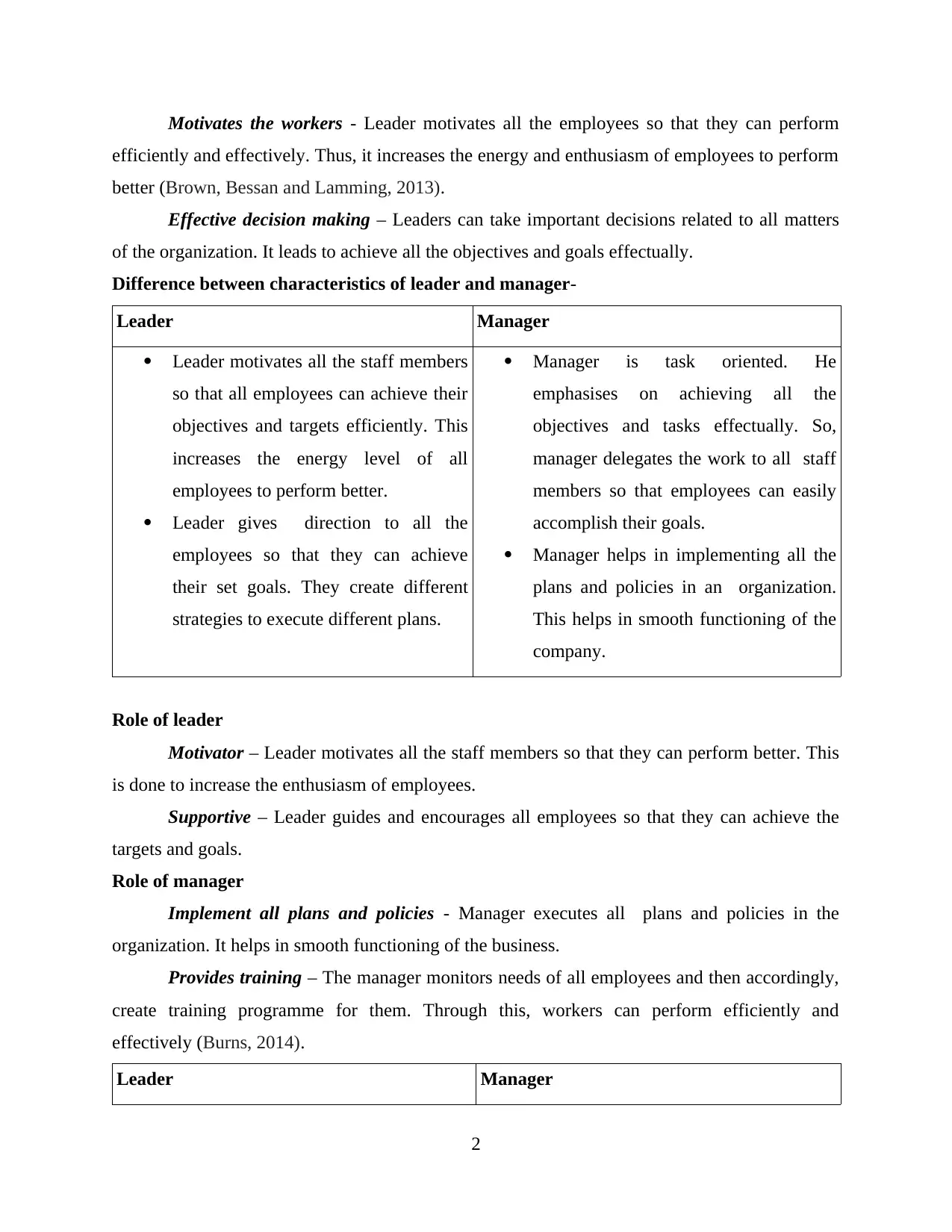
Motivates the workers - Leader motivates all the employees so that they can perform
efficiently and effectively. Thus, it increases the energy and enthusiasm of employees to perform
better (Brown, Bessan and Lamming, 2013).
Effective decision making – Leaders can take important decisions related to all matters
of the organization. It leads to achieve all the objectives and goals effectually.
Difference between characteristics of leader and manager-
Leader Manager
Leader motivates all the staff members
so that all employees can achieve their
objectives and targets efficiently. This
increases the energy level of all
employees to perform better.
Leader gives direction to all the
employees so that they can achieve
their set goals. They create different
strategies to execute different plans.
Manager is task oriented. He
emphasises on achieving all the
objectives and tasks effectually. So,
manager delegates the work to all staff
members so that employees can easily
accomplish their goals.
Manager helps in implementing all the
plans and policies in an organization.
This helps in smooth functioning of the
company.
Role of leader
Motivator – Leader motivates all the staff members so that they can perform better. This
is done to increase the enthusiasm of employees.
Supportive – Leader guides and encourages all employees so that they can achieve the
targets and goals.
Role of manager
Implement all plans and policies - Manager executes all plans and policies in the
organization. It helps in smooth functioning of the business.
Provides training – The manager monitors needs of all employees and then accordingly,
create training programme for them. Through this, workers can perform efficiently and
effectively (Burns, 2014).
Leader Manager
2
efficiently and effectively. Thus, it increases the energy and enthusiasm of employees to perform
better (Brown, Bessan and Lamming, 2013).
Effective decision making – Leaders can take important decisions related to all matters
of the organization. It leads to achieve all the objectives and goals effectually.
Difference between characteristics of leader and manager-
Leader Manager
Leader motivates all the staff members
so that all employees can achieve their
objectives and targets efficiently. This
increases the energy level of all
employees to perform better.
Leader gives direction to all the
employees so that they can achieve
their set goals. They create different
strategies to execute different plans.
Manager is task oriented. He
emphasises on achieving all the
objectives and tasks effectually. So,
manager delegates the work to all staff
members so that employees can easily
accomplish their goals.
Manager helps in implementing all the
plans and policies in an organization.
This helps in smooth functioning of the
company.
Role of leader
Motivator – Leader motivates all the staff members so that they can perform better. This
is done to increase the enthusiasm of employees.
Supportive – Leader guides and encourages all employees so that they can achieve the
targets and goals.
Role of manager
Implement all plans and policies - Manager executes all plans and policies in the
organization. It helps in smooth functioning of the business.
Provides training – The manager monitors needs of all employees and then accordingly,
create training programme for them. Through this, workers can perform efficiently and
effectively (Burns, 2014).
Leader Manager
2
Paraphrase This Document
Need a fresh take? Get an instant paraphrase of this document with our AI Paraphraser
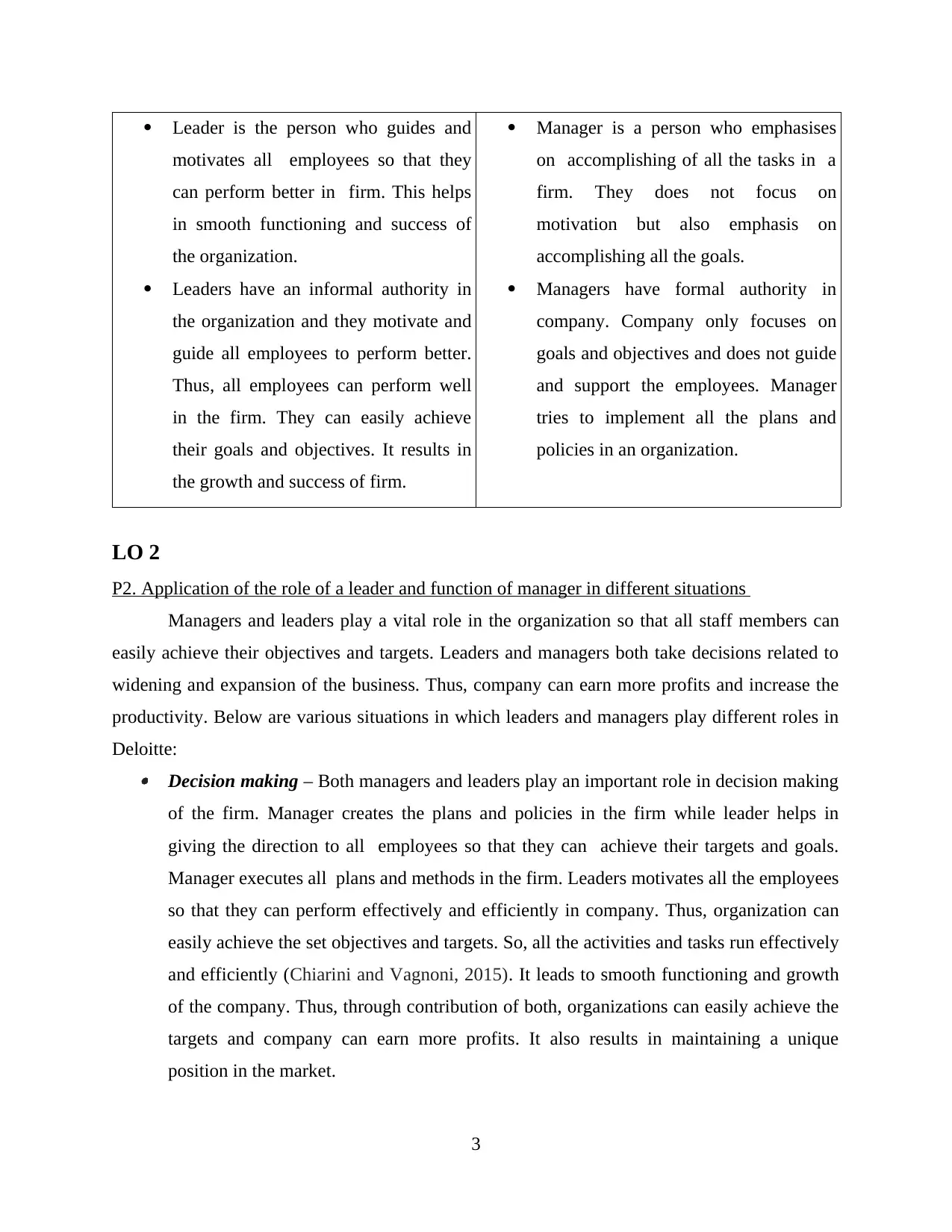
Leader is the person who guides and
motivates all employees so that they
can perform better in firm. This helps
in smooth functioning and success of
the organization.
Leaders have an informal authority in
the organization and they motivate and
guide all employees to perform better.
Thus, all employees can perform well
in the firm. They can easily achieve
their goals and objectives. It results in
the growth and success of firm.
Manager is a person who emphasises
on accomplishing of all the tasks in a
firm. They does not focus on
motivation but also emphasis on
accomplishing all the goals.
Managers have formal authority in
company. Company only focuses on
goals and objectives and does not guide
and support the employees. Manager
tries to implement all the plans and
policies in an organization.
LO 2
P2. Application of the role of a leader and function of manager in different situations
Managers and leaders play a vital role in the organization so that all staff members can
easily achieve their objectives and targets. Leaders and managers both take decisions related to
widening and expansion of the business. Thus, company can earn more profits and increase the
productivity. Below are various situations in which leaders and managers play different roles in
Deloitte: Decision making – Both managers and leaders play an important role in decision making
of the firm. Manager creates the plans and policies in the firm while leader helps in
giving the direction to all employees so that they can achieve their targets and goals.
Manager executes all plans and methods in the firm. Leaders motivates all the employees
so that they can perform effectively and efficiently in company. Thus, organization can
easily achieve the set objectives and targets. So, all the activities and tasks run effectively
and efficiently (Chiarini and Vagnoni, 2015). It leads to smooth functioning and growth
of the company. Thus, through contribution of both, organizations can easily achieve the
targets and company can earn more profits. It also results in maintaining a unique
position in the market.
3
motivates all employees so that they
can perform better in firm. This helps
in smooth functioning and success of
the organization.
Leaders have an informal authority in
the organization and they motivate and
guide all employees to perform better.
Thus, all employees can perform well
in the firm. They can easily achieve
their goals and objectives. It results in
the growth and success of firm.
Manager is a person who emphasises
on accomplishing of all the tasks in a
firm. They does not focus on
motivation but also emphasis on
accomplishing all the goals.
Managers have formal authority in
company. Company only focuses on
goals and objectives and does not guide
and support the employees. Manager
tries to implement all the plans and
policies in an organization.
LO 2
P2. Application of the role of a leader and function of manager in different situations
Managers and leaders play a vital role in the organization so that all staff members can
easily achieve their objectives and targets. Leaders and managers both take decisions related to
widening and expansion of the business. Thus, company can earn more profits and increase the
productivity. Below are various situations in which leaders and managers play different roles in
Deloitte: Decision making – Both managers and leaders play an important role in decision making
of the firm. Manager creates the plans and policies in the firm while leader helps in
giving the direction to all employees so that they can achieve their targets and goals.
Manager executes all plans and methods in the firm. Leaders motivates all the employees
so that they can perform effectively and efficiently in company. Thus, organization can
easily achieve the set objectives and targets. So, all the activities and tasks run effectively
and efficiently (Chiarini and Vagnoni, 2015). It leads to smooth functioning and growth
of the company. Thus, through contribution of both, organizations can easily achieve the
targets and company can earn more profits. It also results in maintaining a unique
position in the market.
3
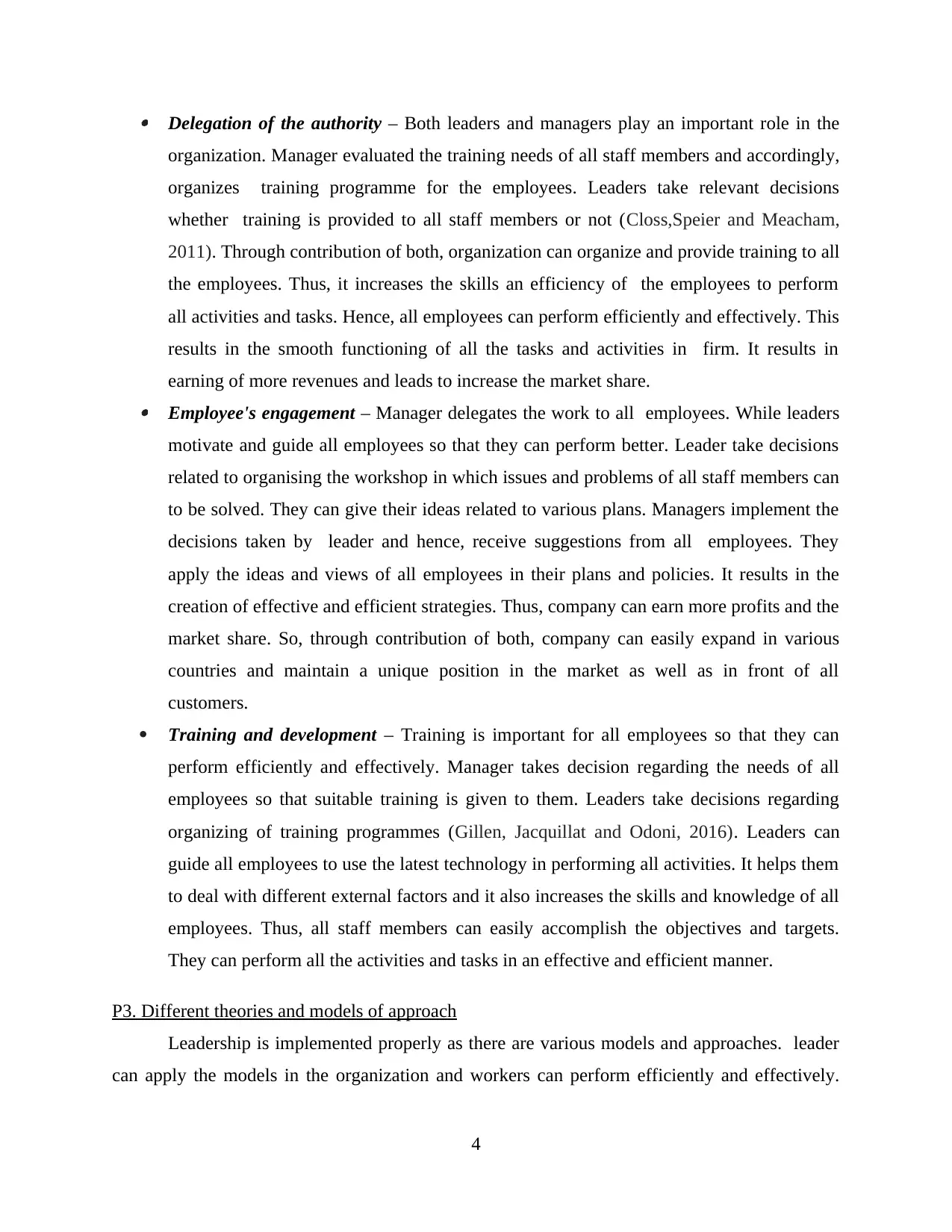
Delegation of the authority – Both leaders and managers play an important role in the
organization. Manager evaluated the training needs of all staff members and accordingly,
organizes training programme for the employees. Leaders take relevant decisions
whether training is provided to all staff members or not (Closs,Speier and Meacham,
2011). Through contribution of both, organization can organize and provide training to all
the employees. Thus, it increases the skills an efficiency of the employees to perform
all activities and tasks. Hence, all employees can perform efficiently and effectively. This
results in the smooth functioning of all the tasks and activities in firm. It results in
earning of more revenues and leads to increase the market share. Employee's engagement – Manager delegates the work to all employees. While leaders
motivate and guide all employees so that they can perform better. Leader take decisions
related to organising the workshop in which issues and problems of all staff members can
to be solved. They can give their ideas related to various plans. Managers implement the
decisions taken by leader and hence, receive suggestions from all employees. They
apply the ideas and views of all employees in their plans and policies. It results in the
creation of effective and efficient strategies. Thus, company can earn more profits and the
market share. So, through contribution of both, company can easily expand in various
countries and maintain a unique position in the market as well as in front of all
customers.
Training and development – Training is important for all employees so that they can
perform efficiently and effectively. Manager takes decision regarding the needs of all
employees so that suitable training is given to them. Leaders take decisions regarding
organizing of training programmes (Gillen, Jacquillat and Odoni, 2016). Leaders can
guide all employees to use the latest technology in performing all activities. It helps them
to deal with different external factors and it also increases the skills and knowledge of all
employees. Thus, all staff members can easily accomplish the objectives and targets.
They can perform all the activities and tasks in an effective and efficient manner.
P3. Different theories and models of approach
Leadership is implemented properly as there are various models and approaches. leader
can apply the models in the organization and workers can perform efficiently and effectively.
4
organization. Manager evaluated the training needs of all staff members and accordingly,
organizes training programme for the employees. Leaders take relevant decisions
whether training is provided to all staff members or not (Closs,Speier and Meacham,
2011). Through contribution of both, organization can organize and provide training to all
the employees. Thus, it increases the skills an efficiency of the employees to perform
all activities and tasks. Hence, all employees can perform efficiently and effectively. This
results in the smooth functioning of all the tasks and activities in firm. It results in
earning of more revenues and leads to increase the market share. Employee's engagement – Manager delegates the work to all employees. While leaders
motivate and guide all employees so that they can perform better. Leader take decisions
related to organising the workshop in which issues and problems of all staff members can
to be solved. They can give their ideas related to various plans. Managers implement the
decisions taken by leader and hence, receive suggestions from all employees. They
apply the ideas and views of all employees in their plans and policies. It results in the
creation of effective and efficient strategies. Thus, company can earn more profits and the
market share. So, through contribution of both, company can easily expand in various
countries and maintain a unique position in the market as well as in front of all
customers.
Training and development – Training is important for all employees so that they can
perform efficiently and effectively. Manager takes decision regarding the needs of all
employees so that suitable training is given to them. Leaders take decisions regarding
organizing of training programmes (Gillen, Jacquillat and Odoni, 2016). Leaders can
guide all employees to use the latest technology in performing all activities. It helps them
to deal with different external factors and it also increases the skills and knowledge of all
employees. Thus, all staff members can easily accomplish the objectives and targets.
They can perform all the activities and tasks in an effective and efficient manner.
P3. Different theories and models of approach
Leadership is implemented properly as there are various models and approaches. leader
can apply the models in the organization and workers can perform efficiently and effectively.
4
⊘ This is a preview!⊘
Do you want full access?
Subscribe today to unlock all pages.

Trusted by 1+ million students worldwide
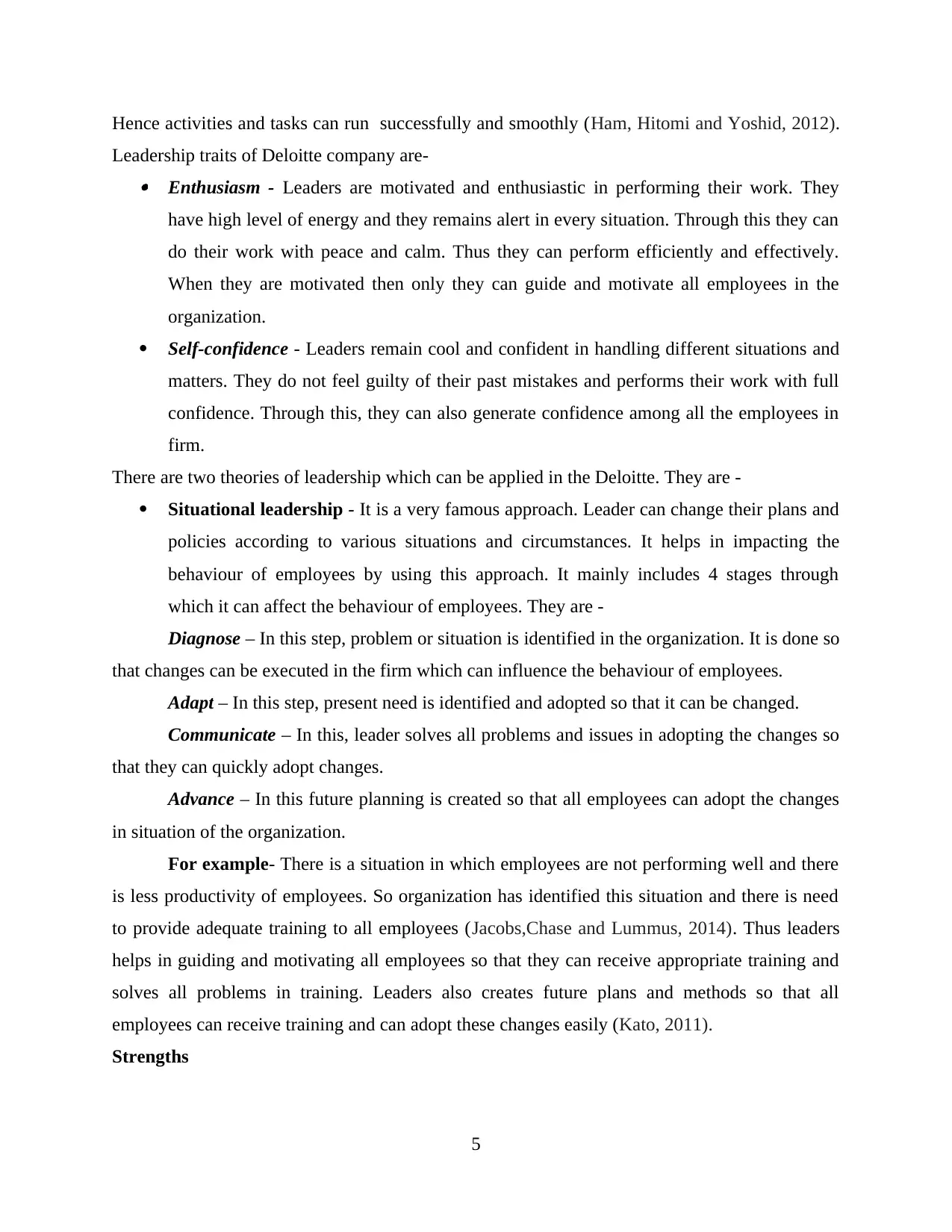
Hence activities and tasks can run successfully and smoothly (Ham, Hitomi and Yoshid, 2012).
Leadership traits of Deloitte company are- Enthusiasm - Leaders are motivated and enthusiastic in performing their work. They
have high level of energy and they remains alert in every situation. Through this they can
do their work with peace and calm. Thus they can perform efficiently and effectively.
When they are motivated then only they can guide and motivate all employees in the
organization.
Self-confidence - Leaders remain cool and confident in handling different situations and
matters. They do not feel guilty of their past mistakes and performs their work with full
confidence. Through this, they can also generate confidence among all the employees in
firm.
There are two theories of leadership which can be applied in the Deloitte. They are -
Situational leadership - It is a very famous approach. Leader can change their plans and
policies according to various situations and circumstances. It helps in impacting the
behaviour of employees by using this approach. It mainly includes 4 stages through
which it can affect the behaviour of employees. They are -
Diagnose – In this step, problem or situation is identified in the organization. It is done so
that changes can be executed in the firm which can influence the behaviour of employees.
Adapt – In this step, present need is identified and adopted so that it can be changed.
Communicate – In this, leader solves all problems and issues in adopting the changes so
that they can quickly adopt changes.
Advance – In this future planning is created so that all employees can adopt the changes
in situation of the organization.
For example- There is a situation in which employees are not performing well and there
is less productivity of employees. So organization has identified this situation and there is need
to provide adequate training to all employees (Jacobs,Chase and Lummus, 2014). Thus leaders
helps in guiding and motivating all employees so that they can receive appropriate training and
solves all problems in training. Leaders also creates future plans and methods so that all
employees can receive training and can adopt these changes easily (Kato, 2011).
Strengths
5
Leadership traits of Deloitte company are- Enthusiasm - Leaders are motivated and enthusiastic in performing their work. They
have high level of energy and they remains alert in every situation. Through this they can
do their work with peace and calm. Thus they can perform efficiently and effectively.
When they are motivated then only they can guide and motivate all employees in the
organization.
Self-confidence - Leaders remain cool and confident in handling different situations and
matters. They do not feel guilty of their past mistakes and performs their work with full
confidence. Through this, they can also generate confidence among all the employees in
firm.
There are two theories of leadership which can be applied in the Deloitte. They are -
Situational leadership - It is a very famous approach. Leader can change their plans and
policies according to various situations and circumstances. It helps in impacting the
behaviour of employees by using this approach. It mainly includes 4 stages through
which it can affect the behaviour of employees. They are -
Diagnose – In this step, problem or situation is identified in the organization. It is done so
that changes can be executed in the firm which can influence the behaviour of employees.
Adapt – In this step, present need is identified and adopted so that it can be changed.
Communicate – In this, leader solves all problems and issues in adopting the changes so
that they can quickly adopt changes.
Advance – In this future planning is created so that all employees can adopt the changes
in situation of the organization.
For example- There is a situation in which employees are not performing well and there
is less productivity of employees. So organization has identified this situation and there is need
to provide adequate training to all employees (Jacobs,Chase and Lummus, 2014). Thus leaders
helps in guiding and motivating all employees so that they can receive appropriate training and
solves all problems in training. Leaders also creates future plans and methods so that all
employees can receive training and can adopt these changes easily (Kato, 2011).
Strengths
5
Paraphrase This Document
Need a fresh take? Get an instant paraphrase of this document with our AI Paraphraser
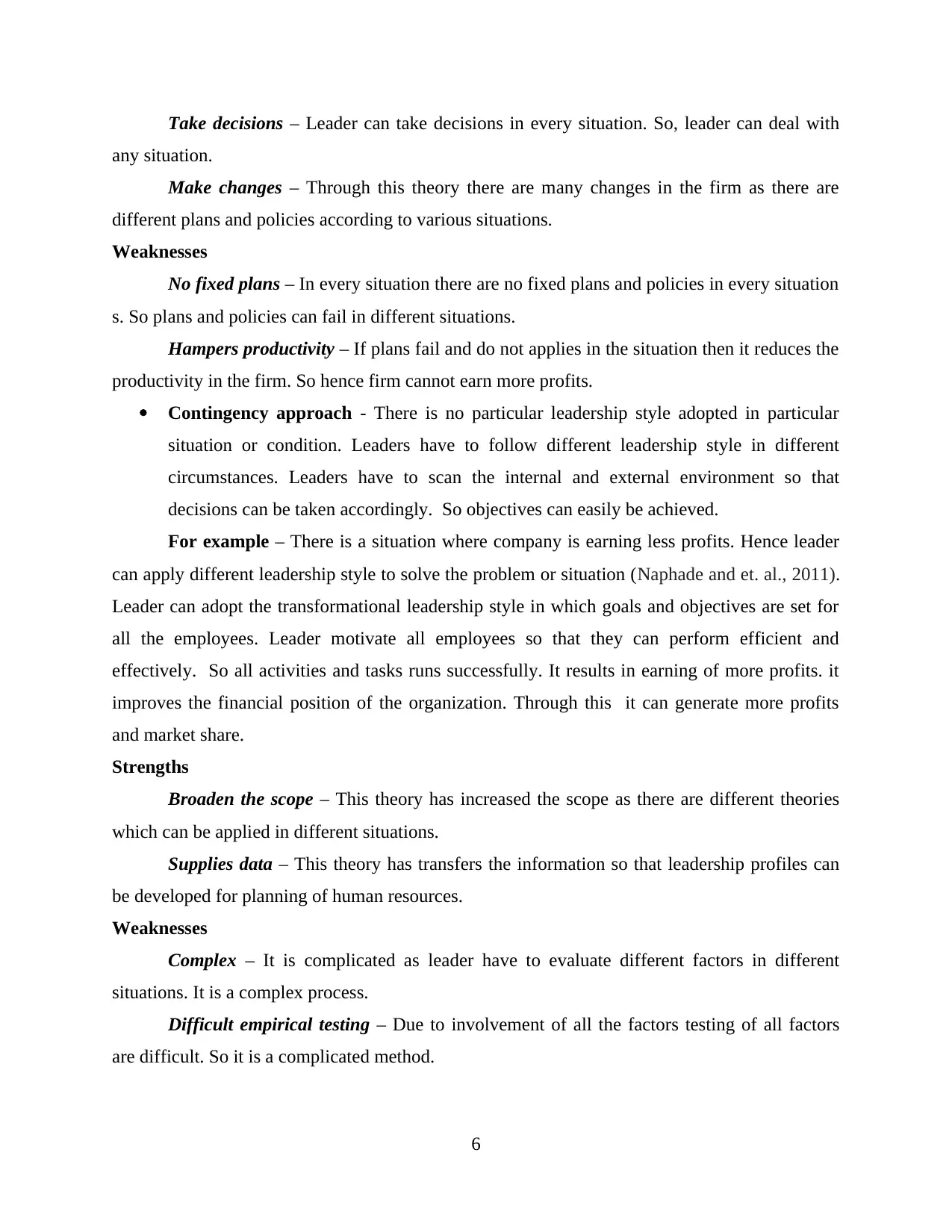
Take decisions – Leader can take decisions in every situation. So, leader can deal with
any situation.
Make changes – Through this theory there are many changes in the firm as there are
different plans and policies according to various situations.
Weaknesses
No fixed plans – In every situation there are no fixed plans and policies in every situation
s. So plans and policies can fail in different situations.
Hampers productivity – If plans fail and do not applies in the situation then it reduces the
productivity in the firm. So hence firm cannot earn more profits.
Contingency approach - There is no particular leadership style adopted in particular
situation or condition. Leaders have to follow different leadership style in different
circumstances. Leaders have to scan the internal and external environment so that
decisions can be taken accordingly. So objectives can easily be achieved.
For example – There is a situation where company is earning less profits. Hence leader
can apply different leadership style to solve the problem or situation (Naphade and et. al., 2011).
Leader can adopt the transformational leadership style in which goals and objectives are set for
all the employees. Leader motivate all employees so that they can perform efficient and
effectively. So all activities and tasks runs successfully. It results in earning of more profits. it
improves the financial position of the organization. Through this it can generate more profits
and market share.
Strengths
Broaden the scope – This theory has increased the scope as there are different theories
which can be applied in different situations.
Supplies data – This theory has transfers the information so that leadership profiles can
be developed for planning of human resources.
Weaknesses
Complex – It is complicated as leader have to evaluate different factors in different
situations. It is a complex process.
Difficult empirical testing – Due to involvement of all the factors testing of all factors
are difficult. So it is a complicated method.
6
any situation.
Make changes – Through this theory there are many changes in the firm as there are
different plans and policies according to various situations.
Weaknesses
No fixed plans – In every situation there are no fixed plans and policies in every situation
s. So plans and policies can fail in different situations.
Hampers productivity – If plans fail and do not applies in the situation then it reduces the
productivity in the firm. So hence firm cannot earn more profits.
Contingency approach - There is no particular leadership style adopted in particular
situation or condition. Leaders have to follow different leadership style in different
circumstances. Leaders have to scan the internal and external environment so that
decisions can be taken accordingly. So objectives can easily be achieved.
For example – There is a situation where company is earning less profits. Hence leader
can apply different leadership style to solve the problem or situation (Naphade and et. al., 2011).
Leader can adopt the transformational leadership style in which goals and objectives are set for
all the employees. Leader motivate all employees so that they can perform efficient and
effectively. So all activities and tasks runs successfully. It results in earning of more profits. it
improves the financial position of the organization. Through this it can generate more profits
and market share.
Strengths
Broaden the scope – This theory has increased the scope as there are different theories
which can be applied in different situations.
Supplies data – This theory has transfers the information so that leadership profiles can
be developed for planning of human resources.
Weaknesses
Complex – It is complicated as leader have to evaluate different factors in different
situations. It is a complex process.
Difficult empirical testing – Due to involvement of all the factors testing of all factors
are difficult. So it is a complicated method.
6
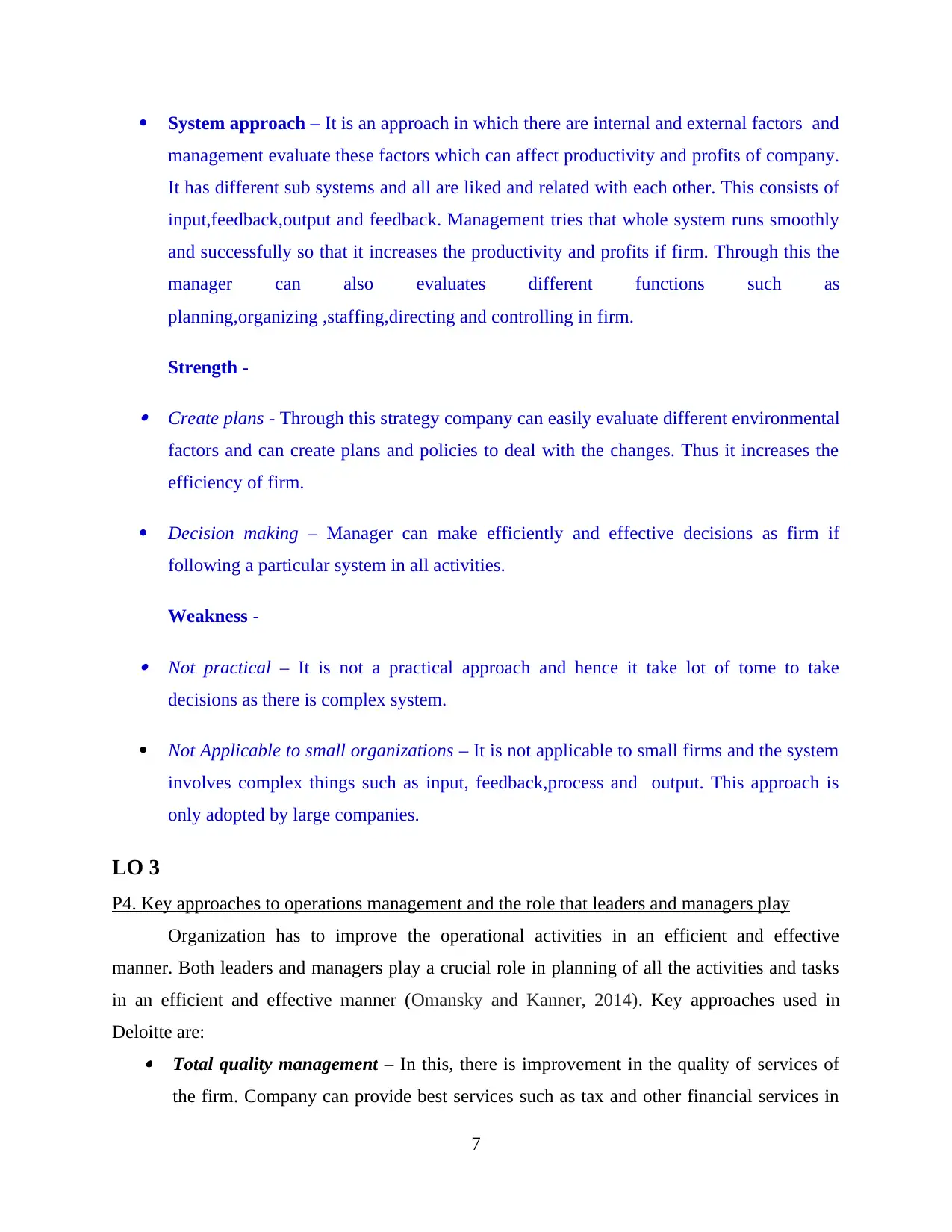
System approach – It is an approach in which there are internal and external factors and
management evaluate these factors which can affect productivity and profits of company.
It has different sub systems and all are liked and related with each other. This consists of
input,feedback,output and feedback. Management tries that whole system runs smoothly
and successfully so that it increases the productivity and profits if firm. Through this the
manager can also evaluates different functions such as
planning,organizing ,staffing,directing and controlling in firm.
Strength -
Create plans - Through this strategy company can easily evaluate different environmental
factors and can create plans and policies to deal with the changes. Thus it increases the
efficiency of firm.
Decision making – Manager can make efficiently and effective decisions as firm if
following a particular system in all activities.
Weakness -
Not practical – It is not a practical approach and hence it take lot of tome to take
decisions as there is complex system.
Not Applicable to small organizations – It is not applicable to small firms and the system
involves complex things such as input, feedback,process and output. This approach is
only adopted by large companies.
LO 3
P4. Key approaches to operations management and the role that leaders and managers play
Organization has to improve the operational activities in an efficient and effective
manner. Both leaders and managers play a crucial role in planning of all the activities and tasks
in an efficient and effective manner (Omansky and Kanner, 2014). Key approaches used in
Deloitte are: Total quality management – In this, there is improvement in the quality of services of
the firm. Company can provide best services such as tax and other financial services in
7
management evaluate these factors which can affect productivity and profits of company.
It has different sub systems and all are liked and related with each other. This consists of
input,feedback,output and feedback. Management tries that whole system runs smoothly
and successfully so that it increases the productivity and profits if firm. Through this the
manager can also evaluates different functions such as
planning,organizing ,staffing,directing and controlling in firm.
Strength -
Create plans - Through this strategy company can easily evaluate different environmental
factors and can create plans and policies to deal with the changes. Thus it increases the
efficiency of firm.
Decision making – Manager can make efficiently and effective decisions as firm if
following a particular system in all activities.
Weakness -
Not practical – It is not a practical approach and hence it take lot of tome to take
decisions as there is complex system.
Not Applicable to small organizations – It is not applicable to small firms and the system
involves complex things such as input, feedback,process and output. This approach is
only adopted by large companies.
LO 3
P4. Key approaches to operations management and the role that leaders and managers play
Organization has to improve the operational activities in an efficient and effective
manner. Both leaders and managers play a crucial role in planning of all the activities and tasks
in an efficient and effective manner (Omansky and Kanner, 2014). Key approaches used in
Deloitte are: Total quality management – In this, there is improvement in the quality of services of
the firm. Company can provide best services such as tax and other financial services in
7
⊘ This is a preview!⊘
Do you want full access?
Subscribe today to unlock all pages.

Trusted by 1+ million students worldwide
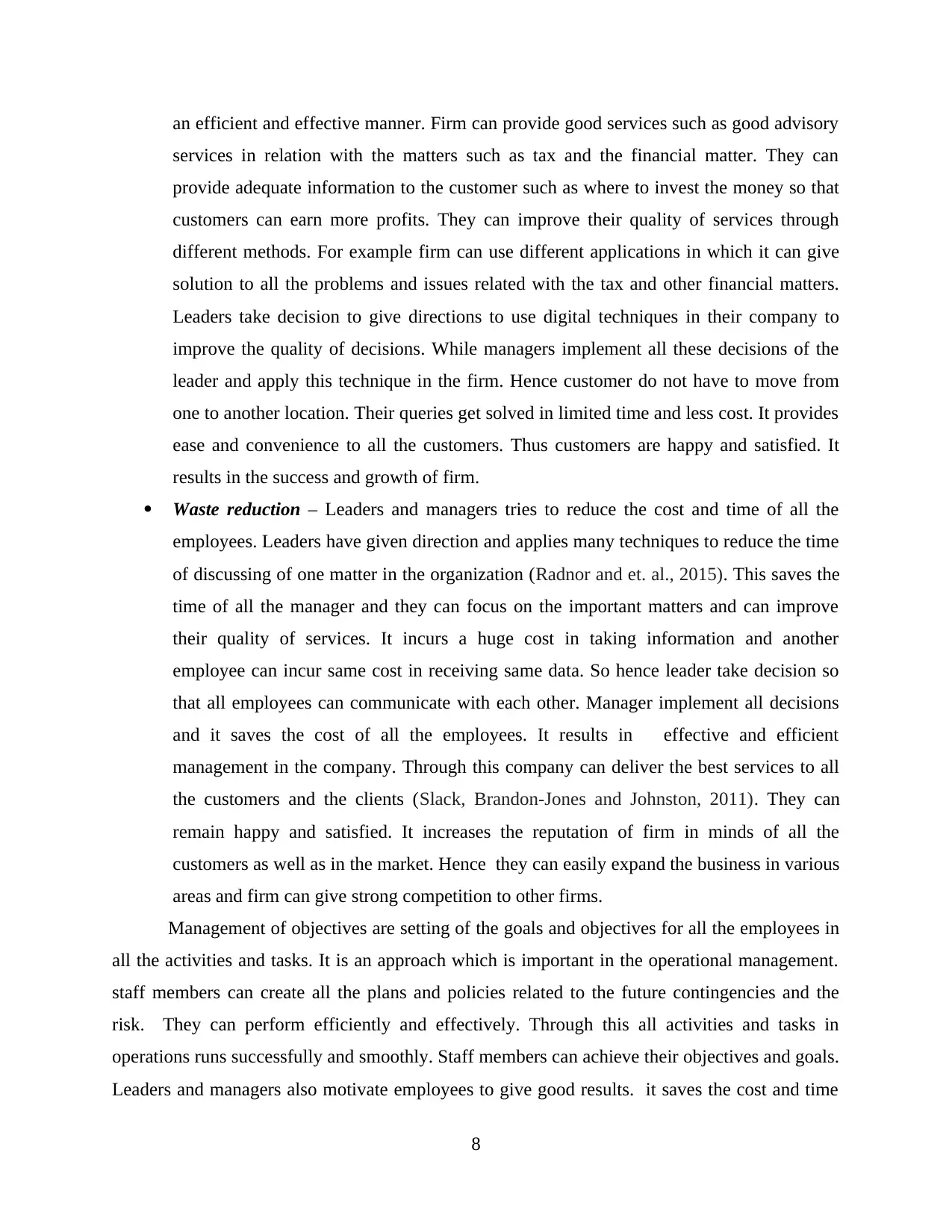
an efficient and effective manner. Firm can provide good services such as good advisory
services in relation with the matters such as tax and the financial matter. They can
provide adequate information to the customer such as where to invest the money so that
customers can earn more profits. They can improve their quality of services through
different methods. For example firm can use different applications in which it can give
solution to all the problems and issues related with the tax and other financial matters.
Leaders take decision to give directions to use digital techniques in their company to
improve the quality of decisions. While managers implement all these decisions of the
leader and apply this technique in the firm. Hence customer do not have to move from
one to another location. Their queries get solved in limited time and less cost. It provides
ease and convenience to all the customers. Thus customers are happy and satisfied. It
results in the success and growth of firm.
Waste reduction – Leaders and managers tries to reduce the cost and time of all the
employees. Leaders have given direction and applies many techniques to reduce the time
of discussing of one matter in the organization (Radnor and et. al., 2015). This saves the
time of all the manager and they can focus on the important matters and can improve
their quality of services. It incurs a huge cost in taking information and another
employee can incur same cost in receiving same data. So hence leader take decision so
that all employees can communicate with each other. Manager implement all decisions
and it saves the cost of all the employees. It results in effective and efficient
management in the company. Through this company can deliver the best services to all
the customers and the clients (Slack, Brandon-Jones and Johnston, 2011). They can
remain happy and satisfied. It increases the reputation of firm in minds of all the
customers as well as in the market. Hence they can easily expand the business in various
areas and firm can give strong competition to other firms.
Management of objectives are setting of the goals and objectives for all the employees in
all the activities and tasks. It is an approach which is important in the operational management.
staff members can create all the plans and policies related to the future contingencies and the
risk. They can perform efficiently and effectively. Through this all activities and tasks in
operations runs successfully and smoothly. Staff members can achieve their objectives and goals.
Leaders and managers also motivate employees to give good results. it saves the cost and time
8
services in relation with the matters such as tax and the financial matter. They can
provide adequate information to the customer such as where to invest the money so that
customers can earn more profits. They can improve their quality of services through
different methods. For example firm can use different applications in which it can give
solution to all the problems and issues related with the tax and other financial matters.
Leaders take decision to give directions to use digital techniques in their company to
improve the quality of decisions. While managers implement all these decisions of the
leader and apply this technique in the firm. Hence customer do not have to move from
one to another location. Their queries get solved in limited time and less cost. It provides
ease and convenience to all the customers. Thus customers are happy and satisfied. It
results in the success and growth of firm.
Waste reduction – Leaders and managers tries to reduce the cost and time of all the
employees. Leaders have given direction and applies many techniques to reduce the time
of discussing of one matter in the organization (Radnor and et. al., 2015). This saves the
time of all the manager and they can focus on the important matters and can improve
their quality of services. It incurs a huge cost in taking information and another
employee can incur same cost in receiving same data. So hence leader take decision so
that all employees can communicate with each other. Manager implement all decisions
and it saves the cost of all the employees. It results in effective and efficient
management in the company. Through this company can deliver the best services to all
the customers and the clients (Slack, Brandon-Jones and Johnston, 2011). They can
remain happy and satisfied. It increases the reputation of firm in minds of all the
customers as well as in the market. Hence they can easily expand the business in various
areas and firm can give strong competition to other firms.
Management of objectives are setting of the goals and objectives for all the employees in
all the activities and tasks. It is an approach which is important in the operational management.
staff members can create all the plans and policies related to the future contingencies and the
risk. They can perform efficiently and effectively. Through this all activities and tasks in
operations runs successfully and smoothly. Staff members can achieve their objectives and goals.
Leaders and managers also motivate employees to give good results. it saves the cost and time
8
Paraphrase This Document
Need a fresh take? Get an instant paraphrase of this document with our AI Paraphraser
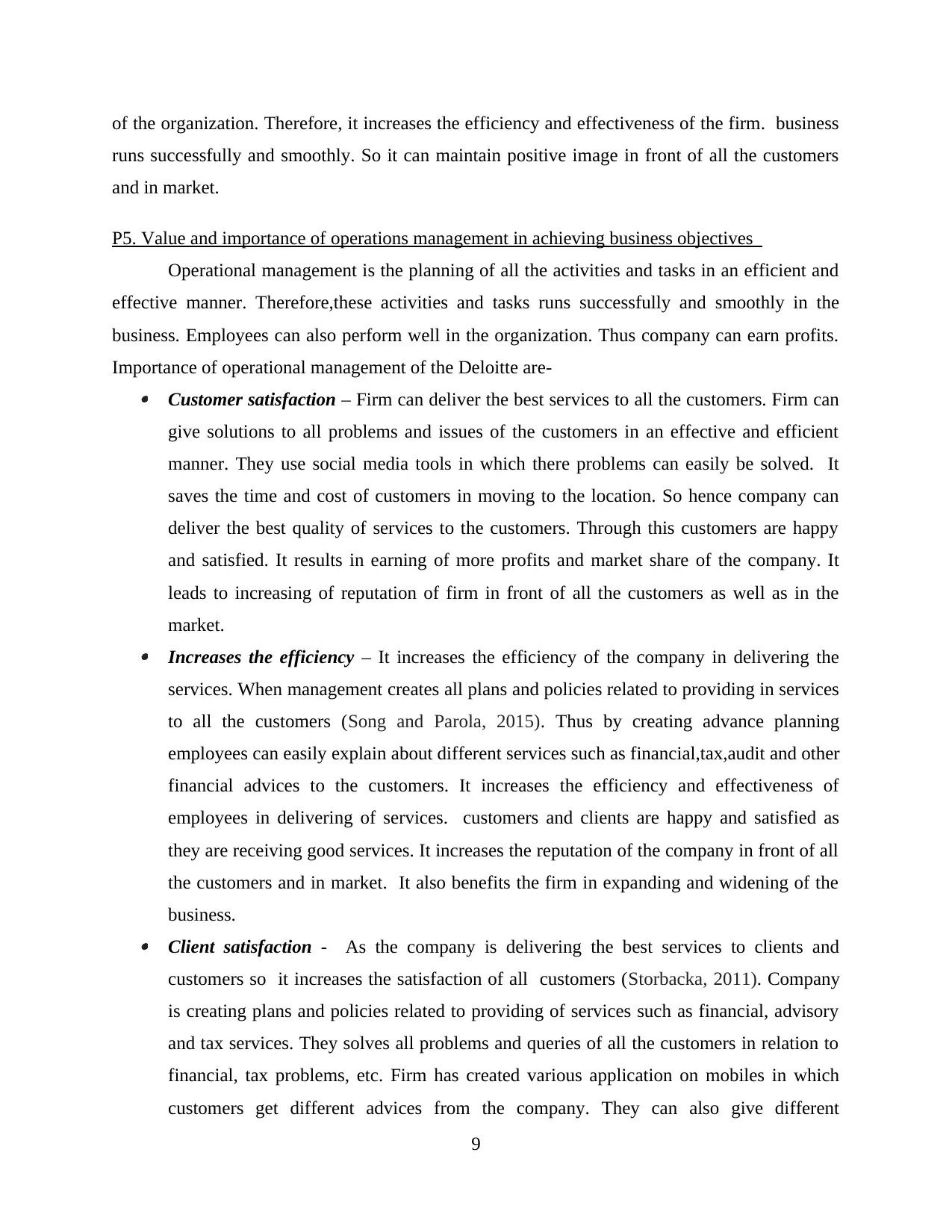
of the organization. Therefore, it increases the efficiency and effectiveness of the firm. business
runs successfully and smoothly. So it can maintain positive image in front of all the customers
and in market.
P5. Value and importance of operations management in achieving business objectives
Operational management is the planning of all the activities and tasks in an efficient and
effective manner. Therefore,these activities and tasks runs successfully and smoothly in the
business. Employees can also perform well in the organization. Thus company can earn profits.
Importance of operational management of the Deloitte are- Customer satisfaction – Firm can deliver the best services to all the customers. Firm can
give solutions to all problems and issues of the customers in an effective and efficient
manner. They use social media tools in which there problems can easily be solved. It
saves the time and cost of customers in moving to the location. So hence company can
deliver the best quality of services to the customers. Through this customers are happy
and satisfied. It results in earning of more profits and market share of the company. It
leads to increasing of reputation of firm in front of all the customers as well as in the
market. Increases the efficiency – It increases the efficiency of the company in delivering the
services. When management creates all plans and policies related to providing in services
to all the customers (Song and Parola, 2015). Thus by creating advance planning
employees can easily explain about different services such as financial,tax,audit and other
financial advices to the customers. It increases the efficiency and effectiveness of
employees in delivering of services. customers and clients are happy and satisfied as
they are receiving good services. It increases the reputation of the company in front of all
the customers and in market. It also benefits the firm in expanding and widening of the
business. Client satisfaction - As the company is delivering the best services to clients and
customers so it increases the satisfaction of all customers (Storbacka, 2011). Company
is creating plans and policies related to providing of services such as financial, advisory
and tax services. They solves all problems and queries of all the customers in relation to
financial, tax problems, etc. Firm has created various application on mobiles in which
customers get different advices from the company. They can also give different
9
runs successfully and smoothly. So it can maintain positive image in front of all the customers
and in market.
P5. Value and importance of operations management in achieving business objectives
Operational management is the planning of all the activities and tasks in an efficient and
effective manner. Therefore,these activities and tasks runs successfully and smoothly in the
business. Employees can also perform well in the organization. Thus company can earn profits.
Importance of operational management of the Deloitte are- Customer satisfaction – Firm can deliver the best services to all the customers. Firm can
give solutions to all problems and issues of the customers in an effective and efficient
manner. They use social media tools in which there problems can easily be solved. It
saves the time and cost of customers in moving to the location. So hence company can
deliver the best quality of services to the customers. Through this customers are happy
and satisfied. It results in earning of more profits and market share of the company. It
leads to increasing of reputation of firm in front of all the customers as well as in the
market. Increases the efficiency – It increases the efficiency of the company in delivering the
services. When management creates all plans and policies related to providing in services
to all the customers (Song and Parola, 2015). Thus by creating advance planning
employees can easily explain about different services such as financial,tax,audit and other
financial advices to the customers. It increases the efficiency and effectiveness of
employees in delivering of services. customers and clients are happy and satisfied as
they are receiving good services. It increases the reputation of the company in front of all
the customers and in market. It also benefits the firm in expanding and widening of the
business. Client satisfaction - As the company is delivering the best services to clients and
customers so it increases the satisfaction of all customers (Storbacka, 2011). Company
is creating plans and policies related to providing of services such as financial, advisory
and tax services. They solves all problems and queries of all the customers in relation to
financial, tax problems, etc. Firm has created various application on mobiles in which
customers get different advices from the company. They can also give different
9
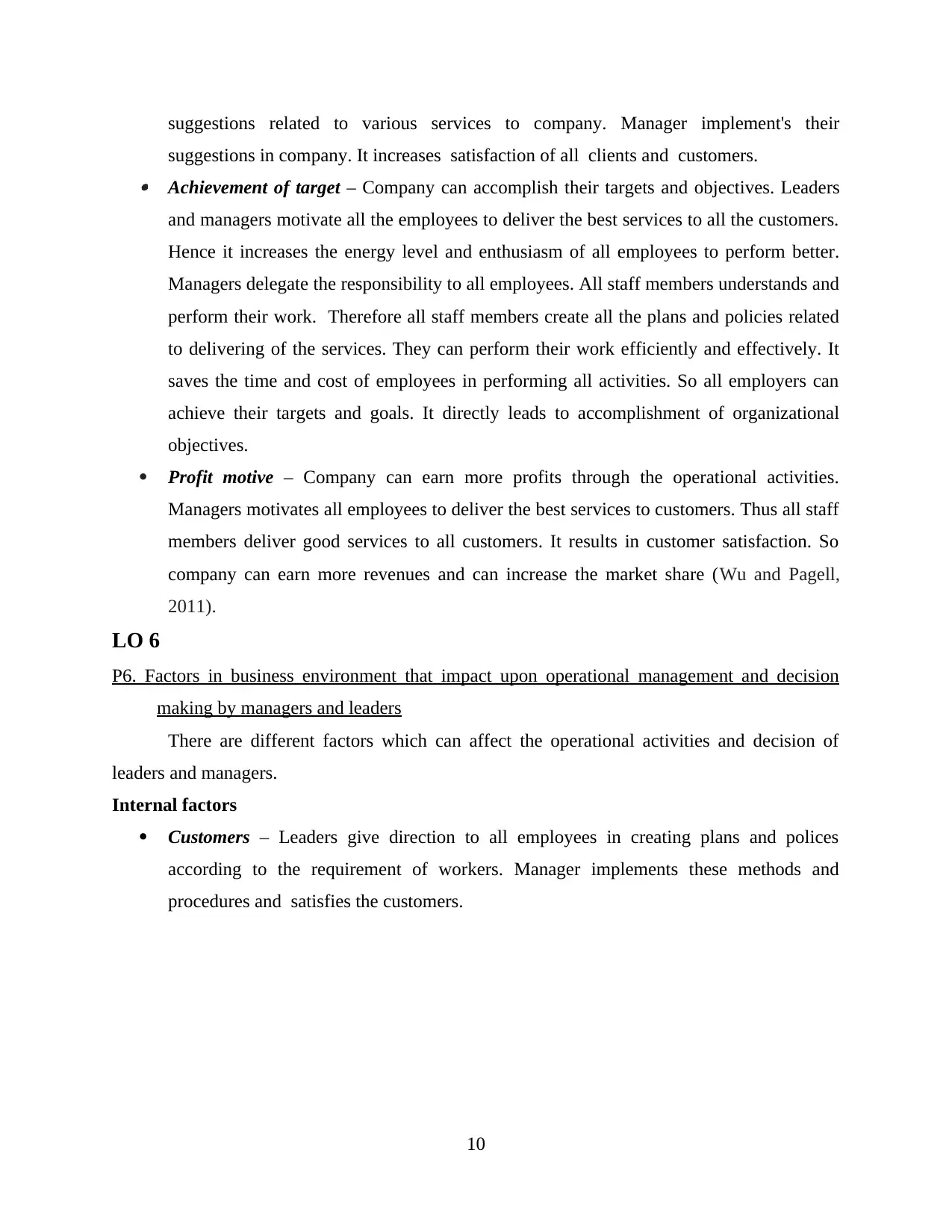
suggestions related to various services to company. Manager implement's their
suggestions in company. It increases satisfaction of all clients and customers. Achievement of target – Company can accomplish their targets and objectives. Leaders
and managers motivate all the employees to deliver the best services to all the customers.
Hence it increases the energy level and enthusiasm of all employees to perform better.
Managers delegate the responsibility to all employees. All staff members understands and
perform their work. Therefore all staff members create all the plans and policies related
to delivering of the services. They can perform their work efficiently and effectively. It
saves the time and cost of employees in performing all activities. So all employers can
achieve their targets and goals. It directly leads to accomplishment of organizational
objectives.
Profit motive – Company can earn more profits through the operational activities.
Managers motivates all employees to deliver the best services to customers. Thus all staff
members deliver good services to all customers. It results in customer satisfaction. So
company can earn more revenues and can increase the market share (Wu and Pagell,
2011).
LO 6
P6. Factors in business environment that impact upon operational management and decision
making by managers and leaders
There are different factors which can affect the operational activities and decision of
leaders and managers.
Internal factors
Customers – Leaders give direction to all employees in creating plans and polices
according to the requirement of workers. Manager implements these methods and
procedures and satisfies the customers.
10
suggestions in company. It increases satisfaction of all clients and customers. Achievement of target – Company can accomplish their targets and objectives. Leaders
and managers motivate all the employees to deliver the best services to all the customers.
Hence it increases the energy level and enthusiasm of all employees to perform better.
Managers delegate the responsibility to all employees. All staff members understands and
perform their work. Therefore all staff members create all the plans and policies related
to delivering of the services. They can perform their work efficiently and effectively. It
saves the time and cost of employees in performing all activities. So all employers can
achieve their targets and goals. It directly leads to accomplishment of organizational
objectives.
Profit motive – Company can earn more profits through the operational activities.
Managers motivates all employees to deliver the best services to customers. Thus all staff
members deliver good services to all customers. It results in customer satisfaction. So
company can earn more revenues and can increase the market share (Wu and Pagell,
2011).
LO 6
P6. Factors in business environment that impact upon operational management and decision
making by managers and leaders
There are different factors which can affect the operational activities and decision of
leaders and managers.
Internal factors
Customers – Leaders give direction to all employees in creating plans and polices
according to the requirement of workers. Manager implements these methods and
procedures and satisfies the customers.
10
⊘ This is a preview!⊘
Do you want full access?
Subscribe today to unlock all pages.

Trusted by 1+ million students worldwide
1 out of 16
Related Documents
Your All-in-One AI-Powered Toolkit for Academic Success.
+13062052269
info@desklib.com
Available 24*7 on WhatsApp / Email
![[object Object]](/_next/static/media/star-bottom.7253800d.svg)
Unlock your academic potential
Copyright © 2020–2025 A2Z Services. All Rights Reserved. Developed and managed by ZUCOL.





